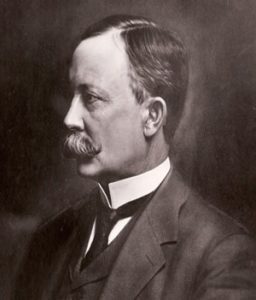As a country, America loves to celebrate the latest thing. Fads of all sorts play a role in our lives and our conversations. The tech sector is far from immune from this phenomenon, as we’re constantly and rightly focused on what comes next. But as we set our sights on the future, it’s important that we also learn from the past. The examples set by innovators from prior eras can teach and even inspire us today.
That’s one reason why July 24 is an interesting day. There’s an inspiring story spanning more than 130 years that started on this very day. On July 24, 1883, Warren Johnson filed his patent application for the Electro Tele-thermoscope, the first thermostat to monitor room temperature. Although today it may seem a humble invention, it has changed and improved the world. And it gave birth to an impressive company — Johnson Controls, or JCI — that is a model of the resilience required to innovate on a sustained basis over time.

Warren Johnson, inventor of Tele-thermoscope, 1880s

Sketch of Warren Johnson’s Electro Tele-thermoscope patent
Warren’s invention helped solve a basic human problem: keeping people warm in a large building in the middle of winter. Warren himself came from humble beginnings, having been raised on a homestead in western Wisconsin in the mid-1800s. He lacked a formal education, but had a curious mind. That sense of curiosity led him to become a professor at the State Normal School, in what is now the University of Wisconsin-Whitewater.
Wisconsin winters are cold. While a basement furnace heated the various rooms in the building where Warren taught, a janitor needed to walk the halls to check whether the rooms were too hot or too cold. After interrupting classes, the janitor would then return to the basement to adjust the flow of heat.
It was neither convenient nor efficient. Warren realized that this was a problem that technology could solve. That inspiration led to his invention: a device that gauged a room’s air temperature and let the janitor know if the heating damper in the basement needed to be opened wider or closed.
Warren soon realized that he not only had an invention on his hands, but the beginnings of a new business. He moved to Milwaukee to raise money, and soon he was leading the company that still bears his name. He and his engineers developed better and better thermostats, and began to manufacture them in growing quantities.
On July 24, 1883, Warren Johnson filed his patent application for the Electro Tele-thermoscope, the first thermostat to monitor room temperature.

Johnson Controls’ thermostats found their way into important buildings around the world, including the U.S. Capitol, the New York Stock Exchange, a factory in Poland, and a palace in Tokyo. In 1908, the world’s tallest skyscraper opened its doors in New York. The 47-story Singer Building housed the headquarters of the company that pioneered one of the great inventions of the age, the sewing machine that brought a higher standard of living to the nation and that eased the toil of the generation of women that used it. The building was made possible by three inventions — steel, elevators, and 1,200 thermostats from Johnson Controls.
Johnson Controls continued to innovate its way into a broadening range of products including tower clocks, electric storage batteries, wireless telegraphs, steam-powered luxury cars, postal service trucks, and seating for automobiles. Over the years, some product lines have come and gone, while others, like the thermostat, have endured.
The company’s employees designed and built the large chiller and HVAC units that sit on the roofs or inside the basements of buildings to provide heating and air conditioning.
By combining smart thermostats with intelligent controls systems, we see the potential to transform energy use for buildings around the world. In a world where buildings devour massive amounts of energy — in the U.S. alone buildings consume 40 percent of all electricity — these units play a vital role not just in enabling modern life, but in helping address issues like environmental sustainability. And in buildings like hospitals, their continuing operation is not just a question of efficiency and comfort, but whether lifesaving surgeries and treatment proceed smoothly.
But if a company is fortunate enough to live a long life, one thing becomes clear: Times are not always good. The headlines about Johnson Controls in the 1990s and 2000s were often about plant closings and layoffs. In many ways, the story of Johnson Controls is therefore emblematic of both the success of much of the middle of the United States in the early 20th century, as well as the challenges the region confronted as the century drew to a close. Manufacturing and innovation itself moved around the world, and many American companies confronted new challenges from lower-cost suppliers on other continents.

But where some other companies collapsed, Johnson Controls persisted. It combined a continuing resilience with new creative sparks of innovation. And it was here that we at Microsoft were privileged to help play a supporting role. Starting in 2012, our two companies began working together to combine digital technologies like our Azure platform with units like chillers and HVAC units.
Six years later, Johnson Controls has a new world-leading set of technologies and services that enables its customers to manage their buildings at levels of reliability, efficiency, and sustainability that were unimaginable two decades ago.
This includes new chillers that are manufactured with sensors connected to the internet. It includes the company’s Smart Connected Chillers platform, which enables technicians to use digital tools and predictive analytics to help identify early indicators of potential issues and address them before they become problems. And it includes new services that enable Johnson Controls itself to manage directly and electronically over 40,000 buildings across North America.
Among other things, Johnson Controls and its customers have found that Smart Connected Chillers have 66 percent fewer critical emergencies than unconnected chillers. It’s an advance that brings Warren Johnson’s focus on keeping students warm in the winter not just into a new century, but into a new era. It means that those of us who spend time inside a building don’t spend our time thinking about whether the heating or air conditioning is working. We instead spend our time on the activities and purpose that brought us into the building in the first place.
At a company like Microsoft, we’re proud of the fact that we’ve had the opportunity to innovate and pursue a leadership position for 42 years. We know that challenges are not always easy and that one must always keep learning and adapting to new circumstances. Given this, it’s hard not to look at Johnson Controls and its 132 years of life with a bit of awe. It’s a story of longevity that is almost three times our own. It’s a company that literally has outlived every human being who was on the planet on the day it was founded. And it shows that every once in a while, a company can succeed on a quest that has preoccupied humanity over the centuries, finding something that looks a bit like eternal youth.
Inevitably, there’s the opportunity to ask what the rest of us who think about technology can learn from this story. For us, two aspects rise to the top. First, at a time when it’s sometimes tempting for individuals in the tech sector to jump to the next thing when the first thing hits a bump in the road and doesn’t pan out, there’s something to be said for resilience and persistence. They are fundamental attributes that one sees frequently in the successful inventions of individuals and companies alike. But they don’t get as much attention as they deserve. And Johnson Controls reminds us of their importance.
There’s a second aspect of Johnson Controls’ success as well, one that is as simple as it is profound. It’s well captured in the words of Kim Metcalf-Kupres, a senior executive at the company who said to us that “technology for technology’s sake isn’t particularly valuable; applying technology towards solving human problems is where you unlock the value.”
That provided the original source for Warren Johnson’s inspiration, and it’s what continues to move the company forward today.
Those of us who work in the tech sector get excited about new innovations every day. It’s part of why it’s such a fun industry to work in. But the success of Johnson Controls tells us something important about the key to a long life in the tech sector. What matters is not technology by itself, but what technology can do for people.
Today in Technology is a series that highlights important technology developments from the past and discusses the insights they offer for the tech trends and issues of our own day.









